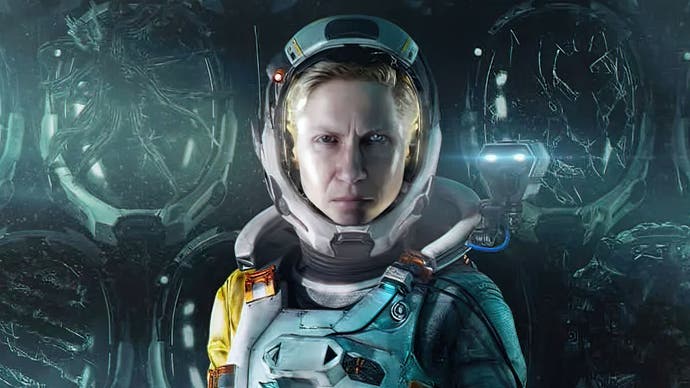Returnal's PC port is good - but it could be great
Housemarque's PS5 masterpiece gets a range of PC upgrades.
Returnal's PC version is absolutely fine for the most part, and certainly leagues beyond many of the Unreal Engine 4 PC ports we've looked at over the last year or so - but there are still some key issues to be aware of before making a purchase. By and large, we're looking at a game that can scale significantly beyond its PlayStation 5 origins, but there are some issues with ray tracing in particular I'd like to see addressed. Optimised settings? We've got those for you too, but in common with much of the work I put into creating these, ultimately what you end up with is a visual balance for the game highly reminiscent of Housemarque's existing work on PS5.
There's much to commend this release though and that begins with the game's first boot, where Returnal pre-compiles all shaders, meaning no shader compilation stutter during play. It's a quick step too - just a six second delay on a Core i9 12900K and an admittedly beefier 35 seconds on a mainstream CPU like the Ryzen 5 3600. There is still stutter, however, of two types. First of all, running any of the UE4-based ray tracing effects can cause hitching and stuttering which the developers are looking to track down and eliminate. The current working theory, we're told, is that it may be related to mesh creation. There's also traversal stutter too - nothing new to Returnal veterans, as this is in the PS5 version to this day. Stutter on opening doors? That's a touch offputting too. Traversal stutter can be minimised with a high-end CPU, but it's still there to a certain extent - and it's much more of an issue on less capable CPUs.
Next up, I've got to say that the benchmark is terrific. No, it's not based on gameplay, but arguably its seven scenarios encompass situations heavier than standard action. What's really cool here is that as you pass through each scenario, the benchmark highlights what the game is stress-testing. The after action report for the benchmark requires praise as well: much like Gears 5, you gain a complete understanding of where the bottlenecks are thanks to the information it gives to you, telling you where and when your CPU or GPU were the limiting factor based upon which section of the benchmark was causing issues.
The settings menu itself is another triumph. Similar to the brilliant Days Gone menu screen, the background fades out and the real-time game world renders behind the options, allowing you to see changes to the visual make-up of the game as you tweak. Supplementing this are explanatory pictures and captions if the adjustments made in real-time are difficult to pick up on. On top of this, in the left-hand corner, the game details CPU and GPU utilisation in the moment, the temperature of your GPU, its clock-rate and even the amount of VRAM used - which lines up with results found in programs like RTSS or CapFrame X. This is next-level stuff!
Image scaling options are wide-ranging - but incomplete. An older version of DLSS is used (you can swap out the .dll for a more recent version if you like), along with XeSS for Intel GPUs. However, only FSR1 from the AMD toolbox is included. Nvidia's NIS is also present, but perhaps of more use for AMD GPUs that support DX12 Ultimate is an actually impressive rendition of tier two variable rate shading (VRS) - a rare thing indeed. There's also a basic spatial upscaler, but a little .ini tweaking can kick in Epic's far more impressive TAAU. Close but no cigar in terms of image upscaling options then, as the lack of FSR2 is frustrating - but the developers tell us they aren't done yet: we should expect to see FSR2 and DLSS 3 integrated in a future patch.
Yes, there's unlocked frame-rate and ultrawide support, the latter working well on 21:9 screens - even on cutscenes. For those aspects of the game that are not authored for ultrawide, you have the choice of what happens there with the menu options: for example, you can make it so 16:9 pre-rendered cutscenes have blurred backgrounds instead of black bars. This is impressive stuff, albeit with one small issue. If you have a 21:10 screen (a 3840x1600 display, for example), gameplay sits within a 21:9 window with only HUD elements stretching out into the pillarboxed borders on the sides.

In terms of scalability over and above PlayStation 5, it's image quality that is easily the most noticeable difference - click on the image above for a closer look. The console version has a native 1080p resolution, using a combination of temporal upscaling and checkerboarding for its reconstructed 4K output. PS5 bests native 1080p, but we didn't find it as impressive as Epic's TAAU solution upscaling from the same base resolution. Native resolution rendering and DLSS deliver a massive detail upgrade compared to PS5, even on the same settings but even DLSS at 1440p in balanced mode offers appreciably more detail than the console rendition of the game. There's also configurability in contrast that offers PC users the chance to 'tune out' the more grey-ish look of the PS5 game.
Beyond this, upgrades are more situational, but RT reflections and shadows are interesting. Looking at reflections first, this primarily affects water. On PS5, water tends to be perfectly transparent with some very light screen-space reflections at times. Ray tracing enhances that by adding in full reflections regardless of angle and I generally think it makes the game look better. It does look different though and as it's a standard UE4 effect, there are imperfections with some object lights not perfectly aligning with the primary view rendering. RT shadows? There is realistic attenuation, with shadows closer to the object casting them looking sharper, but these shadows are limited to those cast by the moon - and many of the light sources are placed by hand, seeing no benefit from RT at all.
Other upgrades? Well, volumetric resolution is higher, but really, it's the improved image quality options and support for the wider range of PC hardware that makes this port shine in relation to the console original. As you can see from optimised settings below, the best balance of visual fidelity and performance essentially comes from mirroring the PS5 graphics feature set as close as possible. I'd recommend watching the video embedded above for a deep dive into how every core setting scales and where the PS5 game slots into the mix.
| PC Optimised Settings | Approx PS5 Settings | |
|---|---|---|
| RT Reflections | Off | Off |
| RT Shadows | Off | Off |
| Volumetric Fog | High | High |
| Ambient Occlusion | Medium | Custom (Low/Med) |
| Model Quality | Epic | Epic |
| Particle Quality | High | High |
| Shadow Quality | High | High |
| Lighting Quality | Epic | Custom (Epic) |
| Texture Quality | Epic | Epic |
Beyond these optimised settings, I recommend DLSS to Nvidia RTX users and XeSS for Intel Arc owners. However, with the absence of FSR2 support right now, AMD RDNA2/RDNA3 GPU owners may like to try a combination of dynamic resolution scaling and VRS. VRS on its own can deliver around a 13 percent performance uplift in darker scenes, with little to no quality loss. For Nvidia GTX users and AMD GPU owners of the older generations, VRS won't work, so DRS alone is the best route forward (Nvidia gamers with GTX 16xx class GPUs should still be able to access VRS, however). The only downer here is that dynamic resolution scaling with v-sync active does not work - but we're all running VRR PC monitors at this point, right? Right?
So, we've covered optimised settings, but what about optimised audio settings? In what may be a first, Returnal taps into RT hardware for ray-traced audio (a feature also embedded in the PS5 original). My hearing is not great, but there is a difference but it comes at a cost of around four percent to performance on an RTX 2060 Super running at optimised settings. There's also less consistent frame-times with this option added - which seems to be the case if any or all RT features are enabled, as I mentioned earlier. My advice? Until the developers have a patch, I think it's best to keep RT disabled.
In summary, there's so much to like about Returnal on PC, aside from its lack of FSR2 at launch and its stutter problems. The settings are excellent, the benchmark is top tier and both of these things should be emulated by other developers. The image quality upgrades alone make this worth looking at, even if you've already played on PS5, while the option to run at 120fps or higher is seriously transformative to a game like this. Honestly, I felt somewhat overpowered playing the game on PC - I did not die during my gameplay run for the b-roll I gathered for the video, all the way up to the third biome, something I could never achieve with a PS5 pad.
But this was the result of playing on a high-end CPU and with ray tracing purposefully turned off to avoid the stutters that are associated with it - and nothing can overcome traversal and door-opening stutter. As good as this port is, these issues are problematic on mainstream CPUs so I would recommend waiting with a purchase if you're on a mid-range rig, where the drawbacks are magnified significantly. On a high-end processor, I can recommend the game as is, with the caveat that ray tracing is disabled. Based on my conversations with the developer throughout the review period, I am optimistic for positive outcomes in addressing my problems with the port as it stands, and we'll do our best to keep you updated with progress.

















